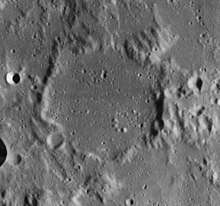Saunder (crater)
Saunder is a lunar impact crater located in the central highland region of the Moon, to the east-northeast of the walled plain Hipparchus. Its diameter is 44 km. It was named after British mathematician Samuel Arthur Saunder.[1] The outer wall is irregular and broken in several locations, forming the overall shape of a pentagon. The interior of Saunder has been flooded with lava, forming a level surface just below the rim. The floor lacks a central peak, but there are low rises in the southeast quadrant and a tiny craterlet towards the north rim.
 Lunar Orbiter 4 image | |
| Coordinates | 4.2°S 8.8°E |
|---|---|
| Diameter | 44 km (27 mi) |
| Depth | 1.3 km (0.81 mi) |
| Colongitude | 352° at sunrise |
| Eponym | Samuel A. Saunder |

Oblique view from Apollo 16
Satellite craters
By convention these features are identified on lunar maps by placing the letter on the side of the crater midpoint that is closest to Saunder.

Saunder and its satellite craters
| Saunder | Latitude | Longitude | Diameter |
|---|---|---|---|
| A | 4.0° S | 12.3° E | 8 km (5.0 mi) |
| B | 3.9° S | 9.8° E | 6 km (3.7 mi) |
| C | 2.7° S | 10.5° E | 4 km (2.5 mi) |
| S | 2.3° S | 9.7° E | 4 km (2.5 mi) |
| T | 4.0° S | 10.4° E | 6 km (3.7 mi) |
gollark: No.
gollark: I *really* ought to overhaul the sandboxing code for potatoos™ already.
gollark: I suppose it's plausible that these are mostly written by people who don't know how loops work.
gollark: It's weird how so many of these bad password programs just reboot and shutdown whenever you do it wrong.
gollark: ```lualocal wireless_modems = {peripheral.find("modem", function(_, o) return o.isWireless() end)}```
References
- "Saunder (crater)". Gazetteer of Planetary Nomenclature. USGS Astrogeology Research Program.
- Andersson, L. E.; Whitaker, E. A. (1982). NASA Catalogue of Lunar Nomenclature. NASA RP-1097.CS1 maint: ref=harv (link)
- Bussey, B.; Spudis, P. (2004). The Clementine Atlas of the Moon. New York: Cambridge University Press. ISBN 978-0-521-81528-4.CS1 maint: ref=harv (link)
- Cocks, Elijah E.; Cocks, Josiah C. (1995). Who's Who on the Moon: A Biographical Dictionary of Lunar Nomenclature. Tudor Publishers. ISBN 978-0-936389-27-1.CS1 maint: ref=harv (link)
- McDowell, Jonathan (July 15, 2007). "Lunar Nomenclature". Jonathan's Space Report. Retrieved 2007-10-24.CS1 maint: ref=harv (link)
- Menzel, D. H.; Minnaert, M.; Levin, B.; Dollfus, A.; Bell, B. (1971). "Report on Lunar Nomenclature by the Working Group of Commission 17 of the IAU". Space Science Reviews. 12 (2): 136–186. Bibcode:1971SSRv...12..136M. doi:10.1007/BF00171763.CS1 maint: ref=harv (link)
- Moore, Patrick (2001). On the Moon. Sterling Publishing Co. ISBN 978-0-304-35469-6.CS1 maint: ref=harv (link)
- Price, Fred W. (1988). The Moon Observer's Handbook. Cambridge University Press. ISBN 978-0-521-33500-3.CS1 maint: ref=harv (link)
- Rükl, Antonín (1990). Atlas of the Moon. Kalmbach Books. ISBN 978-0-913135-17-4.CS1 maint: ref=harv (link)
- Webb, Rev. T. W. (1962). Celestial Objects for Common Telescopes (6th revised ed.). Dover. ISBN 978-0-486-20917-3.CS1 maint: ref=harv (link)
- Whitaker, Ewen A. (1999). Mapping and Naming the Moon. Cambridge University Press. ISBN 978-0-521-62248-6.CS1 maint: ref=harv (link)
- Wlasuk, Peter T. (2000). Observing the Moon. Springer. ISBN 978-1-85233-193-1.CS1 maint: ref=harv (link)
This article is issued from Wikipedia. The text is licensed under Creative Commons - Attribution - Sharealike. Additional terms may apply for the media files.